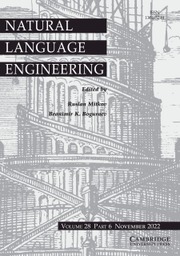Crossref Citations
This article has been cited by the following publications. This list is generated based on data provided by Crossref.
Mohri, Mehryar
Pereira, Fernando
and
Riley, Michael
1998.
Automata Implementation.
Vol. 1436,
Issue. ,
p.
144.
Mohri, M.
Riley, M.
Hindle, D.
Ljolje, A.
and
Pereira, F.
1998.
Full expansion of context-dependent networks in large vocabulary speech recognition.
Vol. 2,
Issue. ,
p.
665.
Mohri, Mehryar
and
Riley, Michael
1999.
Network optimizations for large-vocabulary speech recognition.
Speech Communication,
Vol. 28,
Issue. 1,
p.
1.
Karttunen, Lauri
and
Oflazer, Kemal
2000.
Introduction to the Special Issue on Finite-State Methods in NLP.
Computational Linguistics,
Vol. 26,
Issue. 1,
p.
1.
Sojka, Petr
2000.
Text, Speech and Dialogue.
Vol. 1902,
Issue. ,
p.
157.
Mihov, Stoyan
and
Maurel, Denis
2001.
Implementation and Application of Automata.
Vol. 2088,
Issue. ,
p.
217.
Mohri, Mehryar
Pereira, Fernando
and
Riley, Michael
2002.
Weighted finite-state transducers in speech recognition.
Computer Speech & Language,
Vol. 16,
Issue. 1,
p.
69.
Piskorski, Jakub
Jäger, Tilman
and
Xu, Feiyu
2002.
Databases and Information Systems II.
p.
311.
GUINGNE, FRANCK
NICART, FLORENT
CHAMPARNAUD, JEAN-MARC
KARTTUNEN, LAURI
GAÁL, TAMÁS
and
KEMPE, ANDRÉ
2003.
VIRTUAL OPERATIONS ON VIRTUAL NETWORKS: THE PRIORITY UNION.
International Journal of Foundations of Computer Science,
Vol. 14,
Issue. 06,
p.
1055.
Maurel, Denis
2003.
Grammars and Automata for String Processing.
Vol. 20032543,
Issue. ,
p.
177.
Allauzen, C.
and
Mohri, M.
2003.
Generalized optimization algorithm for speech recognition transducers.
Vol. 1,
Issue. ,
p.
I-352.
Rojc, Matej
and
Kačič, Zdravko
2003.
Efficient Development of Lexical Language Resources and their Representation.
International Journal of Speech Technology,
Vol. 6,
Issue. 3,
p.
259.
Fatholahzadeh, Abolfazl
2003.
Implementation and Application of Automata.
Vol. 2608,
Issue. ,
p.
95.
Wintner, Shuly
2004.
Hebrew Computational Linguistics: Past and Future.
Artificial Intelligence Review,
Vol. 21,
Issue. 2,
p.
113.
Yi-Cheng Pan
Chia-Hsing Yu
and
Lin-Shan Lee
2004.
Large vocabulary continuous Mandarin speech recognition using finite state machine.
p.
5.
Tounsi, L.
Maurel, D.
and
Bouchou, B.
2005.
Basic search of sub automata Application to electronic dictionaries.
p.
543.
Cohen-Sygal, Yael
and
Wintner, Shuly
2006.
Finite-State Methods and Natural Language Processing.
Vol. 4002,
Issue. ,
p.
43.
Galvez, Carmen
2006.
Aplicación de transductores de estado-finito a los procesos de unificación de términos.
Ciência da Informação,
Vol. 35,
Issue. 3,
p.
67.
Cohen-Sygal, Yael
and
Wintner, Shuly
2006.
Finite-State Registered Automata for Non-Concatenative Morphology.
Computational Linguistics,
Vol. 32,
Issue. 1,
p.
49.
Troncoso-Pastoriza, Juan Ramón
Katzenbeisser, Stefan
and
Celik, Mehmet
2007.
Privacy preserving error resilient dna searching through oblivious automata.
p.
519.

